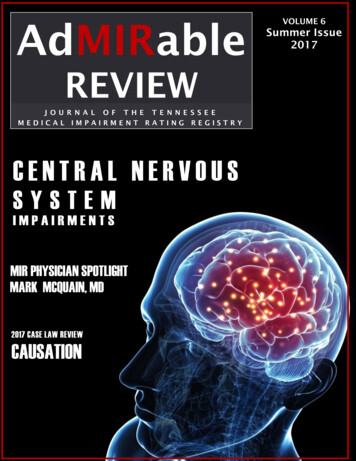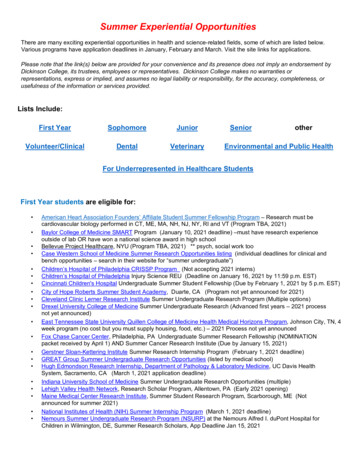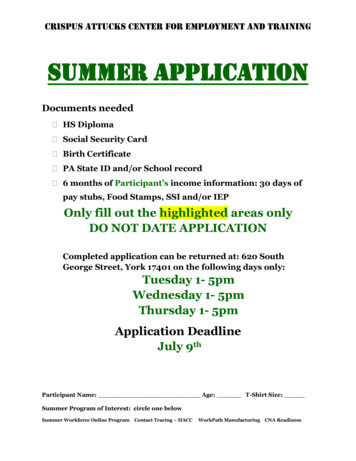
Transcription
AdMIRableVOLUME 6Summer Issue2017REVIEWJ O U R N A L O F T H E T E N N E S S E EMEDICAL IMPAIRMENT RATING REGISTRYCENTRAL NERVOUSSYSTEMIMPAIRMENTSMIR PHYSICIAN SPOTLIGHTMARK MCQUAIN, MD2017 CASE LAW REVIEWCAUSATIONAdMIRable Review Summer 2017
ADVISORY BOARDABBIE HUDGENS, ARM, AICAdministratorJEFF FRANCISAssistant AdministratorTROY HALEY, ESQUIREDirector, AdministrativeLegal Services,Bureau Legislative LiaisonBRIAN HOLMESDirector, Mediation ServicesRICHARD MURRELL, ESQUIREDirector, Quality AssuranceJANE SALEM, ESQUIREStaff Attorney, TN CWCCANNA K. SUDBERRYCommunications CoordinatorTennessee Bureau of Workers’ CompensationBUREAU EVENTS CALENDARAugust 29, 2017, 1:00 PM, Rule-Making Hearing: Public Hearing for amendments to the General rules, Claims Handling Standards rules, and Adjuster Certification Program rules. The hearing will be held in the Tennessee Room at220 French Landing, Suite 1-A, Nashville, TN 37243.September 28, 2017, 10:00 AM, Rule-Making Hearing: Public Hearing foramendments to the Drug Free Workplace rules will be held in the Tennesseeroom at 220 French Landing, Suite 1-A, Nashville, TN 37243.October 17, 2017, 1:00 PM, Medical Payment Committee Meeting will beheld at 220 French Landing Drive, Suite 1-A, Nashville ,TN 37243. Contact SuzyDouglas, Nurse Consultant, TN Bureau of Workers’ Compensation, at (615)532-1326 for more details.4th Annual TN Workers’ Comp Physicians’ Conference: This event will include approved AMA Guides, 6th edition, training prerequisite for appointmentconsideration to the MIRR. Details for this event are to be announced.The 21st TennesseeWorkers' Compensation Educational ConferenceJune 6-8, 2018Embassy Suites Hotel, Nashville SoutheastRegistration details TBA.ROBERT B. SNYDER, MDMedical DirectorKENNETH M. SWITZERChief Judge, TN CWCCASSOCIATE EDITORJAMES B. TALMAGE, MDAssistant Medical DirectorEDITORJAY BLAISDELL, CEDIR VIMIRR Program Coordinator2 AdMIRable Review Summer 2017Medical Impairment Rating RegistryTennessee Bureau of Workers’ Compensation220 French Landing, Suite 1-B, Nashville, TN 37243P: 615.253.5616 F: 615.253.5263 CG.WCMIRProgram@tn.gov
MIR PHYSICIAN SPOTLIGHTMARK MCQUAIN, MD“Ienjoy writing MIR Reports,” saysphysiatrist Mark McQuain, MD, ofJohnson City, Tennessee. “They feellike puzzles to sort out.” Dr. McQuainhas been sorting out MIR puzzles withremarkable accuracy and aplombsince 2005, when he was appointedto the Medical Impairment RatingRegistry. Receiving referrals for disputes that require the musculoskeletal chapters of the AMA Guides, both5th and 6th editions, he faithfullyrenders his impairment opinions bythe book.Christian apologetics and philosophyand regularly contributes to TIU’s Bioethics Blog.Dr. McQuain andhis wife of thirtythree years attendGrace Fellowshipchurch and hold aweekly Bible studyin their home. Intheir free time,they enjoy sailingon beautiful Watauga Lake near Butler,Tennessee. They have three grownsons. One, an attorney, lives in Denver,another, a small business owner, livesin San Francisco, and another, a Marineofficer at Camp Lejeune, lives in Jacksonville, North Carolina All are married.Dr. McQuain is currently board chair-“The Guides are certainly not perfect,”admits Dr. McQuain, “but since wehave all agreed to use them for determining impairment ratings, they needto be used as consistently and accurately as possible.”Board-certified in both physical medicine and rehabilitation, and neuromuscular and electrodiagnostic medicine, Dr. McQuain is a partner of Watauga Orthopaedics, which started in1950 as an orthopaedic surgical practice. It has since morphed into a multi-specialty musculoskeletal practiceto include sports medicine and PM&R.Dr. McQuain and his colleague oftwenty-one years, Pat Flint, care forpatients with chronic neuromusculoskeletal diseases. “It has a hint of afamily practice, since we’ve seenmany of the same patients for manyyears.”While in college at MIT(MassachusettsInstitute of Technology),Dr. McQuain worked asa researcher on a project that became one ofthe 1983 space shuttleexperiments designedto explore why astronauts sufferedmotion sickness in space. His findingsled indirectly to the creation of medications such as Dramamine and Scopolamine. “I was privileged to workwith several space shuttle astronautsbut only recognize them by picturesof their eyes twitching during ocularsaccadic movements that occurredwhile we made them motion sick.”Dr. McQuain grew up in Centerville,Ohio and graduated from CentervilleHigh School in 1978. As president ofthe local chapter of Lamda Chi Alphafraternity while at MIT, he studied andMARK MCQUAIN MDgraduated with a Bachelor of Science degree in electrical engineering. During thesummers he worked at a Texas Instrumentsdivision in Johnson City, Tennessee, wherehe met his future wife, Dee. He graduatedfrom Ohio State University College of Medicine in 1986 and completed residency inPhysical Medicine and Rehabilitation at theMayo Clinic in Rochester, Minnesota in1990. He and his family then moved to Topeka, Kansas, where he served as the medical director for the Kansas RehabilitationHospital for two years before then movingto his wife’s hometown of Johnson City.They have lived there since 1992.In 2013, Dr. McQuain graduated SummaCum Laude with a Master’s degree in Bioethics from Trinity International University(TIU) outside of Chicago. He enjoys readingDoe River Gorge Christian Campman of Doe River Gorge Christian Campin Hampton, TN, where the Gospel message is presented to children ages eightto eighteen during a week-long summercamp experience filled with lake, river,and rock-climbing activities. “It’s muchmore exciting than my day job.”Watauga Orthopaedics, Kingsport, TNAdMIRable Review Summer 20173
CENTRAL NERVOUS SYSTEM IMPAIRMENTS,AMA Guides, 6th EditionJay Blaisdell, CEDIR VI, and James B. Talmage, MDWork injuries that affect thecentral nervous systemcan be catastrophic, since theyinvolve the brain or spinal cord.Determining the underlyingclinical cause of impairment isessential in determining whichGuides chapter to use for ratingpurposes. Most documented neurogenic dysfunctions ofthe brain and spinal cord are rated in Chapter 13, The Central and Peripheral Nervous System. Dysfunctions withoutknown neurogenic causes, including abnormal psychiatricmanifestations, are rated elsewhere in the Guides.INFARCT: a lesion of dead tissue resulting from inadequateblood supply.DEFINITIONSRADICULOPATHY: condition most often caused by a compressed spinal nerve root resulting in pain, numbness, and/ormotor weakness along the course of the nerve.10APHASIA: impairment due to a brain injury severely affecting the production and/or comprehension of speech andthe ability to read or write. It is usually the result of astroke but can also be caused by head trauma, infections,and tumors.1CENTRAL NERVOUS SYSTEM (CNS): the part of the nervoussystem comprised of the brain and spinal cord. The brainconsists of the cerebrum (largest part), brain stem, andcerebellum (hindbrain). The spinal cord is the tubular nervous tissue extending from the medulla oblongata in thebrain stem down to the second lumbar vertebrae.2CEREBRAL: of or relating to the cerebral cortex of thebrain.COMPLEX REGIONAL PAIN SYNDROME (CRPS): an uncommon form of chronic and disproportional limb pain thattypically develops after surgery, stroke, heart attack, orinjury, but can also be idiopathic.3CRANIOCEPHALIC PAIN: head pain or headache.CYSTOSCOPY: endoscopy of the urinary bladder via theurethra, carried out with a cystoscope, allowing the physician to focus on the inner surfaces of the urinary tract.4DYSPHONIA: a descriptive term for all disorders of thevoice involving structures such as the larynx (voice box)and vocal cords, presenting most typically as hoarseness(functional dysphonia) or voice instability and weakness(spasmodic or muscle tension dysphonia).DYSARTHRIA: a disruption to the muscles that are used toproduce speech that has no effect on the ability to understand the meaning of words or manipulate grammar.DYSPHASIA: a moderate, or less severe, form of aphasia. Inmedical terminology, the prefix “a” means absence whilethe prefix “dys” means abnormal.5DYSESTHESIA: abnormal sensation, which often presents aspain, but also as itching, wetness, electric shock, and otherinappropriate responses.6GLOSSOPHARYNGEAL NEURALGIA: a rare condition presenting as severe, yet episodic, pain in the tongue, tonsils, ear,and/or throat. It is caused by irritation of the ninth cranial(glossopharyngeal) nerve.74 AdMIRable Review Summer 2017MIDAS: (Migraine Disability Assessment Questionnaire) a questionnaire used to help determine how “severely migraines affect a patient’s life.”8MSCHIF: abbreviation for Mental Status, Cognition, and HighestIntegrative Function, which is one of the 4 major categories ofcerebral impairments for Guides CNS rating purposes.NEUROGENIC: “Giving rise to or arising from the nerves or nervous system.”9TRIGEMINAL NEURALGIA: a chronic pain that affects the trigeminal nerve, which carries sensation from the face to the brain.11URODYNAMIC TESTING: assesses the bladder’s ability to storeand release fluid through a variety of clinical tests ranging
CENTRAL NERVOUS SYSTEM IMPAIRMENTS,AMA Guides, 6th Edition(Continued from page 4)from post-void residual volume and urethral pressure toEMG of the bladder neck and fluoroscopy (real-time x-rays).CENTRAL NERVOUS SYSTEM RATING PROCESSSCOPESTEP 1: Evaluate all 4 major categories of cerebral impairment and choose the one that is most severe.CHAPTER 13: Documented neurogenic dysfunction leadingto impaired consciousness, respiration, awareness, mentalstatus, reasoning, comprehension of language, use of language, emotional expression, behavior, upper and lowerextremity function, and bowel, bladder, and sexual functionare all rated from Chapter 13, Central and Peripheral Nervous System. Seizures, migraines, dysesthetic and craniocephalic pain, trigeminal and glossopharyngeal neuritis, andcertain miscellaneous nerves, as discussed below, are alsorated in this chapter.CHAPTERS 15 and 16: Radiculopathy, CRPS, and acute lesions on specific peripheral, digital, and plexus nerves arerated in their respective extremity chapters.CHAPTER 14: Emotional, mental, and behavioral disorderswithout clinically documented neurogenic causes are ratedin Chapter 14, Mental and Behavioral Disorders.CHAPTER 12: Visual disorders of all types are rated in Chapter 12, Visual Disorders.CHAPTER 11: Vestibular (balance) disorders, dysarthria, dysphonia, and cranial neuropathies other than trigeminal/glossopharyngeal neuralgia are rated in Chapter 11, Ear,Nose, Throat, and Related Structures.CNS METHODOLOGY OVERVIEWThe first step is to identify the most severely affected category of brain function from the four listed major categories.The MIR Physician then rates the category identified as themost severely affected. Next, all other impairments due toneurogenic problems are rated. Finally, using the combinedvalues chart on page 605, the MIR Physician combines therating of the single most severe cerebral impairment with allother impairments.Unlike the musculoskeletal chapters, Chapter 13 does notutilize grades, grade modifiers, and a net adjustment formula. Instead it utilizes an approach very similar to prior editions of the Guides. Once the correct impaired function andSTEP 2: Rate the single most severe cerebral impairmentof the 4 major categories.STEP 3: Rate all other impairments due to neurogenicproblems.STEP 4: Combine the rating of the single most severecategory of cerebral impairment with the ratings of allother impairments.rating table is identified, the impairment’s class, ranging from0 to 4, is assigned in accordance with the patient’s ability toperform Activities of Daily Living (ADLs), both basic, such asfeeding and toileting, and advanced, such as driving a car andmanaging money. The more that ADLs are adversely affected,the higher the impairment’s class, and, hence, impairmentrating.Within each impairment class is a range of impairment. Sometimes these ranges are large, as in Table 13-4, page 327,“Consciousness and Awareness,” with a Class 4 range of 51%to 100%, and sometimes these ranges are small, as in Table13-17, page 339, “Dysesthetic Pain,” with a Class 4 range of8% to 10%. Regardless, since no modifiers are used to movethe impairment rating from a default value, the MIR Physicianchooses a value within the range that is rationally and incrementally commensurate with the extent that ADLs are affected. The rationale for this choice should be included in the MIRReport.STEP 1: EVALUATE ALL 4 MAJOR CATEGORIES OF CEREBRAL IMPAIRMENT AND CHOOSE THE ONE THAT IS MOSTSEVERE.For rating purposes, cerebral impairments are classified into 4major categories that often overlap: 1. State of consciousnessand level of awareness, whether permanent or episodic, 2.Mental status evaluation and integrative function (MSCHIF), 3.Use and understanding of language, and 4. Influence of behavior and mood. The same traumatic brain injury, for example, could conceivably cause impairment in each of these categories. The MIR Physician is to choose the one that is mostsevere, which means the one that adversely affects ADLs themost.Definitions for the terms describing severity, like “mild” and“severe” are found in section 13.1 on page 322:A minimal impairment in ADLs might be seen in a patient withepilepsy, in whom there are seizures approximately every 2months despite optimal medical mangement. Such a patientwould not be able to drive but would be able to carry out allother ADLs. Another example of minimal ADL impairmentmight be seen in a patient with mild hemiplegia who has recovered most of his or her motor abilities but cannot walklong distances, even with a cane, and cannot do heavy liftingor vigorous activities. All basic ADLs are intact. Moderate impairment of ADLs might be seen in a patient who needs minimal to moderate assistance with basic ADLs but does not reAdMIRable Review Summer 20175
CENTRAL NERVOUS SYSTEM IMPAIRMENTS,AMA Guides, 6th Edition(Continued from page 5)quire extensive assistive care throughout the day. The patientwith severe impairment of ADLs performs few or none oftheir basic ADLs and needs extensive assistive care throughout the day.12The most severely impacted of the 4 categories is used torate the entire group of 4 categories. In other words, choosethe worst.STEP 2: RATE THE SINGLE MOST SEVERE CEREBRAL IMPAIRMENT OF THE 4 MAJOR CATEGORIES.The most severely impacted of the major cerebral categoriesis rated by applying the appropriate table.1. CONSCIOUSNESS AND AWARENESS: The MIR Physician usesTable 13-4, page 327, “Consciousness and Awareness” forrating altered states of consciousness such as persistent vegetative state and coma; Table 13-5, page 328, “Episodic Lossof Consciousness or Awareness,” for rating conditions suchas convulsive disorders; and Table 13-6, page 329, “Sleep andArousal Disorders,” for rating conditions such as sleep apneaand narcolepsy.2. ALTERATION IN MSCHIF: Table 13-8, page 331, is used forrating impairment due to alteration in mental status cognitionand highest integrative function (MSCHIF). This category ofcerebral impairment includes conditions such as intellect andmemory dysfunction.3. USE AND UNDERSTANDING OF LANGUAGE: Aphasia anddysphasia are rated using Table 13-9, page 382.Activities of Daily LivingBASICADVANCEDBowel StatusDrivingGroomingSexual FunctionToiletingMedical CareFeedingCommunicationPhone, writing letters andchecksTransfersFrom chair to bedIndoor MobilityDressingBathingTravelingAs a passengerShopping(Lifting, carrying groceries)Food PreparationHouseworkAmbulation(Throughout community)Moderate activitiesMoving furniture, golf(From Table13-2, page 323)Vigorous activities(Running, heavy lifting)6 AdMIRable Review Summer 20174. INFLUENCE OF BEHAVIOR AND MOOD: Psychiatric impairments with verifiable neurological causes are rated using the “Global Assessment of Functioning (GAF) Impairment Score” in Table 13-10, page 334. Psychiatric impairments without a verifiable neurological origin are rated inChapter 14, Mental and Behavioral Disorders. Examples ofpermanent behavioral and mood changes caused by objectively verifiable nerve dysfunction are left hemisphere infarct and “deep dejection” and right hemisphere infarct andhyper jocularity.12 (333)STEP 3. RATE ALL OTHER IMPAIRMENTS DUE TO NEUROGENIC PROBLEMS.After the MIR Physician assigns an impairment rating forthe most severe category of cerebral dysfunction, impairments arising from the spinal cord and cranial nerve arerated. These include impairments in station and gait, theupper extremities, bladder and bowel function, and sexualfunction, provided they arise from objectively identifiableneurogenic abnormalities.UPPER EXTREMITY CNS DYSFUNCTION, presenting as tremor, weakness, or altered sensation, and resulting from lesions in the brain or spinal cord, is rated using Table 1311, page 335, with a range of 0% to 60%. These lesionsmay result from a variety of causes, including infection,traumatic brain injury, acute spinal trauma, and neurodegenerative disease, although the latter is not commonlyfound in a workers’ compensation setting. Dysfunctionmay affect one extremity or both, with more impairmentassigned to the dominant side.STATION AND GAIT DISORDERS are rated using Table 1312, page 336, with a range of 0% to 50%. The same neurological pathologies that affect upper extremities may alsoaffect the lower extremities, impairing the patient’s balance and ability to walk, rise from chairs, and climb stairs.NEUROGENIC BOWEL incontinence is rated using Table 1313, page 337, with a range of 0 to 50%. A higher impairment is assigned to bowel incontinence than bladder incontinence.NEUROGENIC BLADDER incontinence is rated using Table13-14, page 337, with a range of 0% to 30%. Diagnosis often involves cystoscopy or urodynamic testing, which theMIR Physician should document.NEUROGENIC SEXUAL DYSFUNCTION is rated using Table13-15, page 338, with a range of 0 to 15%. For males, therating may be adjusted, at the MIR Physician’s discretion,for the patient’s age according to section 7.7 on page 143of Chapter 7, Urinary and Reproductive Systems. For females, the rating may be adjusted if the patient is postmenopausal per Table 7-10, footnote “b,” on page 151 ofChapter 7, Urinary and Reproductive Systems.12NEUROGENIC RESPIRATORY DYSFUNCTION is rated usingTable 13-16, page 338, with a 0% to 65%. Only neurological limitations should be considered for this table. Respiratory impairment with other causes is rated in Chapter 5,The Pulmonary System.
CENTRAL NERVOUS SYSTEM IMPAIRMENTS,AMA Guides, 6th Edition(Continued from page 6)DYSESTHETIC PAIN, secondary to peripheral neuropathy orspinal cord injury, is rated using Table 13-17, page 339,with a range of 0% to 10%. Since pain is the primary featureof this diagnosis, it may not be recognized for TennesseeWorkers’ Compensation claims with dates of injury on orafter July 1, 2014.MIGRAINE HEADACHES are rated using the MIDAS questionnaire. The results of each question are added and applied toTable 13-8, page 342, with a range of 0% to 5%. Nonmigraine headaches are not ratable under the Guides. Migraines are reliably diagnosed when at least 3 of the following criteria are met: the headache 1) affects one half of thehead, 2) is pulsating, 3) lasts 4 to 72 hours, 4) induces nausea or vomiting, 5) causes disability due to sensitivity tolight, sound, or smell.“Documentation of impairment on the MIDAS Questionnaireshould be sought from school and/or work records if possi-STEP 4: COMBINE THE RATING OF THE SINGLE MOST SEVERE CATEGORY OF CEREBRAL IMPAIRMENT WITH THERATINGS OF ALL OTHER IMPAIRMENTS.This is done using Appendix A, Combined Values Chart, onpage 604. Impairments from different organ systems mustfirst be converted to whole person impairment before combining with nervous system impairments.12 (604)CONCLUSIONImpairments due to neurogenic dysfunction of the CNS andperipheral nerves are rated in Chapter 13 according to patient’s ability to perform Activities of Daily Living. Since someneurological dysfunctions are rated elsewhere in the Guides,the MIR Physician may consult Table 13-1 to verify the appropriate chapter to use. Once the correct table and impairmentclass are chosen, rather than simply assigning the highestvalue within the range provided, the MIR Physician shouldconsider choosing a value that is rationally and incrementallycommensurate with the patient’s inability to perform ADLswithin the range. This rationale should be provided in theMIR Report to avoid the appearance of assigning an arbitraryor capricious rating.REFERENCES1. NAA. Aphasia Definitions. sed August 7, 2017.2. Wikipedia. Central Nervous System.https://en.wikipedia.org/wiki/Central nervous system. Accessed August 7,2017.3. Mayo Clinic Staff. Complex Regional Pain on/con-20022844. Accessed August 7, 2017.4. Wikipedia. Cystoscopy. https://en.wikipedia.org/wiki/Cystoscopy. AccessedAugust 7, 2017.ble.”12 (342) Unstated, but perhaps obvious, is that the examiner may downgrade the severity from the questionnaire if thehistory is not judged to be credible.TRIGEMINAL OR GLOSSOPHARYNGEAL NEURALGIA is ratedusing Table 13-19, page 343, with a range of 0% to 6%. Forinjuries on or after July 1, 2014, the MIR Physician should bemindful that, while sensory and motor loss are ratable, thedegree of pain is not. Since there is no “default value” ofimpairment in this table, the examiner may wish to select amid-range number. Happily, this is a very rare condition.MISCELLENEOUS PERIPHERAL NERVES are rated using Table13-20, page 344. These are nerves of the head and trunkthat are not rated elsewhere in the Guides and that were inadvertently omitted in previous editions. The greater andlesser occipital, greater auricular, intercostal, genitofemoral,ilioinguinal, iliohypogastric, and pudendal nerves are all rated here, with a range of 0% to 5%. Again, for injuries occurring on or after July 1, 2014, when the degree of selfreported pain is not supposed to be considered in impairment rating, the examiner may wish to select a mid-rangerating, since the tables contain no “default rating”.5. TTRS. What’s the Difference between Aphasia, Dysphasia, and ce-between-aphasia-dysphasiadysarthria. Accessed August 7, 2017.6. Wikipedia. Dysethesia. https://en.wikipedia.org/wiki/Dysesthesia. Accessed August 7, 2017.7. MedlinePlus. Glossopharyngeal 636.htm. Accessed August 7,2017.8. Wikipedia. Migraine Disability Assessment Test.https://en.wikipedia.org/wiki/Migraine Disability Assessment Test. Accessed August 7, 2017.9. MedicineNet. Medical Definition art.asp?articlekey 4552. Accessed August 7, 2017.10. MedicineNet. athy/article.htm. Accessed August7, 2017.11. Mayo Clinic. Trigeminal Neuralgia. minal-neuralgia/home/ovc-20342542. Accessed August 7,2017.12. Rondinelli R, Genovese E, Katz R, et al. Guides to the Evaluation of Permanent Impairment. 6th ed. Chicago, IL: AMA, 2008.AdMIRable Review Summer 20177
REVIEW OF CAUSATION CASE LAW 2017Jane Salem, Esquire1, 2017 marked the third year of theJ ulyeffective date of the Reform Act. Happybirthday to the Court of Workers’ Compensation Claims and the Workers’ Compensation Appeals Board. As the year is alreadymore than half over, it’s a suitable time tolook back at the case law from the AppealsBoard over the past few months that focuses on causation.Starting with the compensation appeals, Bass v. The HomeDepot U.S.A., Inc. involved the compensability of an allegedwork-related aggravation of an employee’s underlying arthritis. The Board affirmed the trial court’s ruling that Mr.Bass’ independent medical examiner did not rebut the presumption of correctness afforded to the opinion of an authorized treating physician. The Board reached a similarconclusion in Darraj v. McKee Foods Corp., while reiteratingthat self-represented litigants will be held to the samestandard as attorneys. Mr. Darraj also faced a languagebarrier.alleged injury was not work-related. The trial court found theemployee was unlikely to prevail at a hearing on the merits butnonetheless ordered a panel. The Appeals Board reversed thepanel order, citing the IME physician’s opinion as the only medical proof in the case. The Board cautioned employers not to construe its opinion as carte blanche to ignore their obligations under the Claims Handling Standards, and it referred FairfieldGlade to the Bureau's Compliance Unit for consideration of apenalty.The Appeals Board revisited the willful misconduct defense inRoper v. Allegis Group. The Board affirmed the trial court’s ruling that Allegis Group didn’t prove a willful violation of a safetyrule, rejecting its argument that an employee’s lack of a validexcuse to follow a safety rule constitutes “willfulness.” The judges characterized this as an overly broad interpretation of Mitchell v. Fayetteville Public Utilities, which would allow employers todeny benefits to employees whose “merely negligent or recklessactions” result in a violation of a known safety rule.Then in Panzarella v. Amazon.com, Inc., the Board clarifiedthat a physician rendering a causation opinion doesn't needto use the particular words or phrases within the statute’sdefinition of “injury.” Rather than a “rigid recitation” of thestatute, there must be sufficient evidence from which thetrial court can conclude that the statutory requirements aresatisfied. The opinion harmonizes well with Edwards v. TheJob Shoppe U.S.A., an expedited appeal in which the Boardrejected the employer’s “overly-narrow interpretation” of anauthorized treating physician’s report, affirming the trialcourt’s grant of additional medical benefits. The implication is that trial courts and the Appeals Board should consider the record as a whole.As in Edwards, preexisting conditions played a significantrole in two additional cases where the authorized treatingphysicians appeared to give equivocal causation opinions.First, in Gamble v. Miller Industries, Inc., the Appeals Boardvacated the trial court’s order for Miller Industries to authorize the employee’s hip-replacement surgery. The dispute centered around an authorized physician's opinionthat the fall at work “was the proverbial straw that brokethe camel’s back” but that Mr. Gamble’s avascular necrosiswas “long standing and would represent greater than 51%of the need for hip replacement.”Second, in Stallion v. TruGreen, L.P., the authorized physician concluded that Mr. Stallion didn't require further treatment, but if he did, it would be for non-work-related degenerative disc disease. The trial court ordered additional medical benefits, which the Board reversed, reasoning that nophysician had rendered an opinion that satisfied the statutory requirements necessary to establish a compensableaggravation.Moving on, another preexisting injury case—Berdnik v.Fairfield Glade Community Club—definitely merits a readby any Tennessee workers’ compensation practitioner. Inthe case, the employer provided neither treatment nor apanel but denied the claim based largely upon Ms.Berdnik’s history of chronic back problems. Fairfield Gladelater requested an IME, where the physician concluded the8 AdMIRable Review Summer 2017Workers’ Compensation Appeals Board (From left to right):Timothy W. Conner, Knoxville; Marshall L. Davidson, III, Presiding Judge, Nashville;David F. Hensley, Chattanooga.Finally, in Morales v. Boshwit Brothers, the Board examined causation in the context of workplace assaults. Mr. Morales, anapartment complex groundskeeper, suffered serious gunshotwounds from an unknown assailant while mowing the lawn. TheAppeals Board reversed the trial court’s ruling that the streetrisk doctrine did not apply. The Board noted, among other considerations, that signage invited prospective renters on to theproperty to view available units.To conclude, keep in mind that this article represents a smallsampling of the Appeals Board’s work. So far this year–January 1through June 30–the Board issued 37 appellate opinions: sevencompensation appeals and 30 expedited appeals. Of these, 16appeals resulted in issuance of memorandum opinions, whilethe majority presented issues of fact or law of significance towarrant full opinions. It’s also noteworthy (and praiseworthy)that the Appeals Board has yet to issue an opinion past the statutorily mandated timeframes.
admirable review summer 2017 . c e n t r a l n e r v o u s. s y s t e m. i m p a i r m e n t s. admirable . review . j o u r n a l o f t h e t e n n e s s e e. m e d i c a l i m p a i r m e n t r a t i n g r e g i s t r y. mir physician spotlight. mark mcquain, md. volume 6 . summer issue . 2017 . 2










